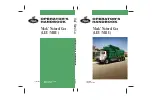
FRONT SUSPENSION 3-5
6. The frame corrected angle, Step 3 above, should cor
respond to the recommended angle on the chart with
in ± 1/2°.
Make changes as necessary to bring
caster angle within limits.
Cam ber
1. Determine v e h i c l e camber angle on alignment
machine.
2. Measure dimension “ A .”
3. Using dimension
“ A ”
and the caster-camber chart
for the appropriate vehicle, shown below, find the
recommended camber angle.
4. If the angle in Step 1 does not correspond to the rec
ommended angle on the chart within ± 1/2°, make
necessary changes.
Shims may be changed at either front or rear to vary
caster, or at both points equally to vary camber (fig. 8).
I Beam A x le Models
On I Beam axles, if camber angle does not fall within
specified limits, the axle center or steering knuckle is
bent; if the axle center is bent, refer to Front Axle Re
pair later in this section; if the steering knuckle is dam
aged, replace as outlined under Steering Knuckle/Steering
Arm later in this section. Caster angle is adjusted by
the use of tapered shims placed between the axle spring
seat and spring. To increase caster, place thick end of
shim toward rear of vehicle; to decrease caster, place
thick end of shim toward front of vehicle (fig. 9).
Toe-In
Toe-in is the amount in fractions of an inch that wheels
are closer together in front than at rear. Check steering
gear high point adjustment and place wheels in straight
ahead position before checking toe-in. Adjustments are
made by loosening clamp bolts at each end of tie rod,
then turning tie rod tube until wheels have proper toe-in.
Tighten clamp bolts securely after proper adjustment is
made. After toe-in adjustment on 4000, 5000 and 7000
lb. axles, tie rod sockets should both be tiled in the same
Fig . 4 —Stop Screw Adjustment
direction, forward or rearward, before tightening clamp
bolts (fig. 10).
Cornering Wheel Relationship
Cornering wheel relationship, or toe-out on turns is
determined by the angle of the steering arms. If, when
checking this angle, toe-out does not fall within specified
limits, it will be necessary to replace defective steering
arm as outlined under Steering Knuckle/Steering Arm
later in this section.
Steering A xis or Kingpin Inclination
Steering axis or kingpin inclination is the tilt of the
steering knuckle kingpin. If the inclination is not within
the specified limits, the steering knuckle is bent and must
be replaced on IFS models; on I beam axle models, the
axle center is bent and must be repaired as outlined un
der Front Axle Repair later in this section.
Fig . 5 —Front End Alignm ent
CHEVROLET TRUCK SERVICE MANUAL
Summary of Contents for 10 Series 1968
Page 1: ...ST 1 3 3 SB...
Page 3: ...w w...
Page 52: ...HEATER AND AIR CONDITIONING 1A 21 Fig 32 Charging Schematic CHEVROLET TRUCK SERVICE MANUAL...
Page 67: ......
Page 128: ...BODY IB 61 Fig 135 A uxiliary Seat CHEVROLET TRUCK SERVICE MANUAL...
Page 132: ...Fig 4 1 0 3 0 Series Truck Frame...
Page 133: ...Fig 5 4 0 6 0 Single A xle Truck Frame E x c Tilt Cab...
Page 135: ...Fig 7 4 0 6 0 Series Tilt Cab Truck Frames...
Page 139: ...w...
Page 169: ...fit w...
Page 233: ...I...
Page 248: ...BRAKES 5 15 TD 50 60 Fig 26 Parking Brake Cables T Models CHEVROLET TRUCK SERVICE MANUAL...
Page 347: ......
Page 389: ......
Page 393: ......
Page 411: ...ENGINE FUEL 6M 18 Fig 18A V 8 Typical CHEVROLET TRUCK SERVICE MANUAL...
Page 525: ......
Page 551: ......
Page 583: ...CHASSIS SHEET METAL 11 12 Fig 20 Designation and Name Plate CHEVROLET TRUCK SERVICE MANUAL...
Page 587: ...ELECTRICAL BODY AND CHASSIS 12 2 Fig 1 Fuse Panel CHEVROLET TRUCK SERVICE MANUAL...
Page 611: ...r ELECTRICAL BODY AND CHASSIS 12 26 9 CHEVROLET TRUCK SERVICE MANUAL...
Page 663: ......
Page 686: ...w...
Page 698: ...SPECIFICATIONS 12 ENGINE TORQUES CHEVROLET TRUCK SERVICE MANUAL...
Page 713: ...9...





































